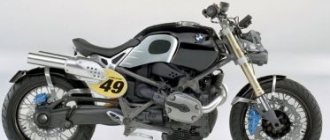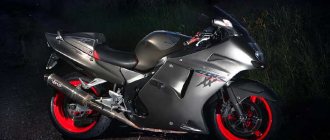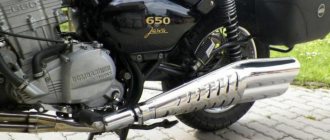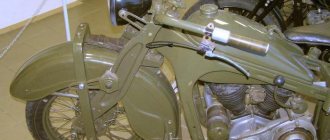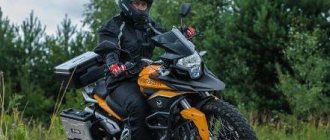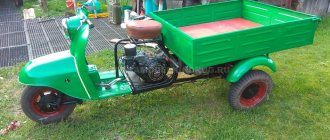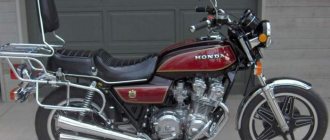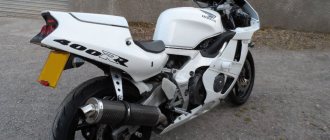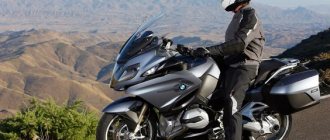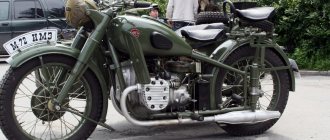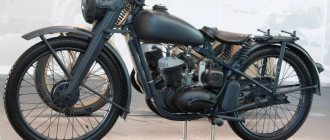Motorcycle with a helicopter engine
A large number of new motorcycle models are produced annually in the world. Manufacturers strive to make their products unique and original. Thanks to this, consumers have the opportunity to purchase those technical exhibits that will allow them to stand out on the roads during their journey.
In terms of technical characteristics, all motorcycles are different. Motorcyclists, as you know, love high speeds, which make them feel free on the track. For this purpose, manufacturers use various engine options. Three years ago, Marine Turbine Technologies launched its first helicopter-powered motorcycle. It differs from all other types of motorcycles not only in its design features, but also in its technical parameters.
Motorcycle intake with helicopter engine
Two years ago, the MTT company presented its first creation to the motorcyclists of this world in the form of the original Y2K bike. It is equipped with an engine with a power of 320. This engine is used in helicopters. It has very high power. The developers made it so that a motorcycle with a helicopter engine could accelerate to one hundred kilometers per hour in one and a half seconds. The manufacturers of this unique motorcycle have created ultra-high-speed equipment that can reach speeds of up to 420 kilometers per hour. This is a dream for any motorcyclist.
In 2012, the motorcycle passed all tests in road conditions. It is quite suitable for use on the trails.
This motorcycle model is the best option for those motorcyclists who simply cannot imagine their life without riding fast. A speed of 400 kilometers per hour is an achievement for such a vehicle.
The design of the motorcycle of this model is original and attractive. The company produces models in a variety of colors. Therefore, consumers have the opportunity to choose the most optimal design option for themselves.
Jet flying motorcycle JPA Speeder
This flying motorcycle with a jet turbine costs $380,000, credit: Jetpack Aviation
Jetpack Aviation (JPA) has announced that it is now accepting pre-orders for its self-stabilizing jet flying motorcycle, the Speeder. It is equipped with a jet turbine engine and is capable of reaching a maximum speed of 240 km per hour, flying for 20 minutes and rising to a height of 4572 meters. The JPA Speeder leverages the company's extensive jet turbine expertise from years of work on the amazing JB-series jetpacks. The motorcycle is equipped with a group of four turbojet engines that produce a total maximum thrust of 340 kgf, which is enough to lift a 105-kg glider and a pilot weighing up to 109 kg into the air.
The motorcycle reaches a speed of 240 km per hour and rises to a height of 4572 meters, credit: Jetpack Aviation
The speeder is also equipped with a control system that allows it to self-stabilize in the air, similar to a quadcopter drone. Its engines run on kerosene, JetA aviation fuel or diesel fuel. It can fly from 10 to 22 minutes, depending on the pilot's weight and altitude.
105 kg speeder lifts a pilot weighing up to 109 kg, credit: Jetpack Aviation
The JPA Speeder flying motorcycle has manual controls, a 12-inch touchscreen for navigation and a built-in two-way aviation radio system for air-to-air and air-to-ground communications. The developer says that in accordance with FAA regulations, it will create different versions of its speeder to fit the ultra-light and recreational categories of flying vehicles. This means that the buyer will be able to use the ultra-light version of the jet glider without any license.
The civilian version of the flying motorcycle has four turbojet engines, credit: Jetpack Aviation
Jetpack Aviation engineers have done a good job on the safety of the flying motorcycle. For example, it is equipped with a ballistic parachute system, in addition, it will automatically stabilize if one of the jet engines fails. Unfortunately, this motorcycle is only capable of flying and cannot be driven on regular roads.
Related article: Frankie Zapata's flying flyboard rises to a height of 3048 meters, stays in the air for up to 10 minutes and reaches speeds of up to 150 km/h.
The company plans to build just 20 JPA Speeder flying motorcycles, each priced at $380,000 . Once this batch is sold out, Jetpack Aviation will focus on the military version of its jet flying motorcycle, which will receive an additional jet turbine and the ability to autonomously fly as a drone or cargo carrier.
JPA Speeder motorcycle engines run on kerosene, JetA aviation fuel or diesel fuel, credit: Jetpack Aviation
To learn more about the JPA Speeder flying motorcycle, watch this video:
13
ShareTweet
Technical characteristics of a motorcycle with a helicopter engine
A motorcycle with a helicopter engine has unique characteristics. Consumers all over the world are attracted not only by its original design, but also by its technical parameters. The motorcycle itself is quite powerful.
In addition to the engine, which makes a large number of revolutions and allows the vehicle to accelerate to 400 kilometers per hour, it has other technical data that deserve attention:
- fuel tank volume 34 liters,
- the weight of the entire structure is 208.7 kilograms,
- power 320 horsepower,
- maximum speed 420 kilometers per hour,
- wheel size 17,
- Accelerates to maximum speed in seconds.
This hyperbike has no analogues anywhere in the world. It is a high-speed device that will appeal to any motorcyclist.
Manufacturers have tried to create a high-tech motorcycle that allows you to enjoy high speeds at any time of the year. Thanks to the gas turbine engine from the helicopter, the motorcycle became a living legend. Its cost started from 200 thousand dollars. Not every motorcyclist can afford to buy such a motorcycle, despite all the love for fast riding.
Source
Motorcyclist
In the Hollywood movie Torque, the main character rides a motorcycle that is as fast as the wind and picks up speed with a sound reminiscent of an airplane taking off. What is this? Prop, special effect? Few people know that this is a real device. An exotic motorcycle from the American company MTT is called MTT Turbine Superbike. You can buy it for 200 thousand dollars, provided that your turn comes, because only five of these motorcycles are produced during the year.
It should be noted that the MTT Turbine Superbike is the only legal motorcycle with a gas turbine engine that is approved for use on regular roads. The heart of the motorcycle is a modified Rolls Royce Allison 250 aviation gas turbine engine, which has power output to the shaft. The weight of the motorcycle is 227 kilograms. Of these, 61.2 kilograms come from the engine, which produces 320 horsepower at fifty-two thousand rpm.
The two-speed automatic transmission, which has a manual shift option, is capable of lowering the revs to normal motorcycle wheel speeds and increasing torque proportionally. Anyone who can tame such a flow of power can accelerate this motorcycle to 365.3 kilometers per hour. When purchasing a superbike, the customer can order the color and seat, which can be single or double. Among the equipment, it is worth noting the rear view video camera, which transmits the image to a color LCD display. In addition, the standard package includes radar detectors that scan the area in front and behind the motorcycle. Carbon wheels complement the design of the bike well.
An aircraft engine can consume automotive diesel fuel, as well as aviation kerosene. It is noteworthy that MTT does not specialize in motorcycles, but the development and use of gas turbine engines, both on land and at sea, is its strong point. That’s why the company receives orders for luxury yachts, military boats, and powerful fire pumps that drive gas turbine engines.
Gas turbine engines have long been tried to be installed on cars, but previously it was ineffective. The company's leading specialists believe that new technologies will change the situation, because the efficiency of gas turbine engines is improving and their prices are falling. The advantages of such motors are balance, a record power-to-weight ratio, and reliable lubrication. Despite the unusual nature of the gas turbine engine and its enormous power, the company promises that the motorcycle will operate for several thousand hours without rebuilding. Although owners of such exotic motorcycles are unlikely to be afraid of expensive maintenance.
SEE ALSO: MOTORCYCLE WITH A HELICOPTER ENGINE HELICOPTER WITH A MOTORCYCLE ENGINE
Motorbike. with a gas turbine engine from a helicopter
The American company Marine Turbine Technologies from Louisiana has built an even more incredible megabike, which, as the developers say, “can go faster than you dare.”
For almost a century and a half, engineers have repeatedly tried to replace internal combustion engines in motorcycles with something. Over the years, they have tried to implant any power plants, from a steam engine to a rotary motor or even an electric motor. But the company Marine Turbine Technologies solved this issue radically: it installed... a turbine from a helicopter in the motorcycle frame!
As a result, the Americans got the world's fastest production motorcycle, the W2K. Thanks to a gas turbine engine with 320 horsepower, it could accelerate to 365 km/h. The motorcycle was produced for five years, after which MTT focused on its core business: the production of marine engines. But the experiments with motorcycles did not end there: now they have developed a new gas turbine megabike called 420RR!
Bolted to its aluminum frame is a Rolls Royce Allison 250-C20 gas turbine engine producing 420 horsepower at 52,000 rpm. The engine is powered by diesel fuel and kerosene and develops a torque of 678 Nm at 2000 rpm. The same engine, by the way, is installed on the Bell OH-58 Kiowa, Bell 206 Jet Ranger and many others helicopters. The wheelbase of the 420RR reaches 173 centimeters.
I wonder how long a 34-liter fuel tank will last? But other characteristics have not yet been reported. The maximum speed of the megabike is expected to exceed 400 km/h, and Marine Turbine Technologies also plans to release a three-wheeled version of the motorcycle. There's no word on pricing yet, but there should be plenty of people willing to buy a motorcycle that sounds like a fighter jet.
Motorcycle with jet engine. Jet motorcycle Maddox PulseJet Jet motorcycle
Unlike the more famous, but very similar to a modern Harley with a V-2 engine (well, you’ve all seen it, right?), in 1972 a motorcycle with a real turbojet engine appeared on American drag racing tracks.
Elon Jack Potter, better known by his nickname "Michigan Crazy," was a legend in American motorcycle drag racing. He became famous by competing in races across the country in the 1960s and 1970s on a motorcycle powered by a Chevrolet V-8 engine. Contemporaries spoke of him as a person for whom victory was not important, but what impression (or rather furor) his appearance caused in the public.
Potter raced motorcycles, bought and homemade, long before he was 16 and could get a license. Just at 16, he came up with the idea of putting a Chevrolet “eight” in a Harley frame. As far as he knew, no one had ever done this before. And although he had to deal with a bunch of technical problems - incredible vibration, unpredictable steering, the front wheel lifting off the road, as Potter himself later said - his youth and ignorance became the main guarantee of the final success of the project. In 1960, the car took to the track and reached 209 km/h.
“Ignorance is the most powerful tool, if used at the right time, sometimes it surpasses any knowledge,” he wrote self-ironically in his own memoirs, published in 1999.
In the late sixties, this same combination of extensive experience (based on his own mistakes) and useful ignorance helped him create a three-wheeled motorcycle powered by a Fairchild J44 aircraft turbojet engine, bought at a sale of decommissioned military equipment. The machine was called Widow Maker (~"Leaving wives widows"). One day, the braking parachute (yes, otherwise it wouldn’t stop) failed, and Elon had to jump off the motorcycle while moving at a speed of 193 km/h. Elon Potter was an early proponent of mandatory motorcycle helmet use.
For 13 years, Mr. Potter traveled along the highways of America. He competed in all the races, receiving from sponsors a dollar for every mile per hour over 100. The rocket-powered trike helped the owner earn more. According to the recollections of contemporaries, he usually made three races a day, earning $150. There were only three runs, because after that we had to throw away the tires.
In 1973, Elon left motorsports and took up tractor racing. Despite his crazy youth, I. J. Potter lived to be 71 years old, leaving behind a daughter, a son and four grandchildren.
He was once asked in an interview how he would compare himself and his famous contemporary Evel Knievel, to which Potter replied: “The difference between us is that he gets paid to say he wants to do something, no matter what.” Whether he succeeds or not, I’m paid only for the result.”
source vk.com/moto_infocar
For motorcyclists, the abbreviation “Y2K” (1) symbolizes not the problem of the year 2000, but a problem with the brain. The brains of those who came up with the idea to build a motorcycle not with a conventional engine, but with a jet turbine. And also with the brains of their customers, to whom the Suzuki Hayabusa began to seem slow. But what to do if the power of the internal combustion engine really becomes low? The solution is to switch to the “External Combustion Engine”.
Before the start, a motorcycle with a jet engine must be rolled manually
This is exactly the kind of madness that Eric Tebul suffers from. The Frenchman decided that even a jet turbine was not enough in drag racing conditions. And he installed an analogue of the rocket engine of the Apollo lunar module on his two-wheeled “projectile”... Thanks to which, in May 2010, he received an official “diagnosis” from the “psycho” timekeepers of the Santa Pod drag strip: a quarter mile in 5.232 seconds, finishing speed - more than 400 km/h. Which means Eric built the fastest accelerating jet motorcycle in the world.
Eric Tebul's team works with the motorcycle without hiding from the audience
The design of Eric's record-breaking bike is both simple and complex. It’s hard to surprise anyone with a steel duplex frame these days. As well as the rigid rear suspension, characteristic of archaic “hardtail” choppers, the usual inverted fork from some serial sports bike, the same serial brake calipers and discs, as well as wheels painted feminine pink. But this is where the apparent simplicity ends, and careful calculations and aerospace technologies begin.
The chassis was designed for ultra-high speeds and enormous aerodynamic loads. In order to make the bike stable, the base was made significantly longer than many of its road counterparts. The steering geometry, which is more chopper than sporty, is designed to further increase stability. The riding position, the fairing, the footpegs - everything is designed to minimize the insane air resistance and mass - the main enemy of acceleration. Because of this, it was necessary to sacrifice the comfort of the pilot, without even providing his “fifth point” with a thin mat made of porous rubber.
White cylinders contain compressed air, silver cylinders contain hydrogen peroxide
But the sweetest “dessert”, of course, was the power unit. Modeled after the rocket thrusters used on the LLVR (2) training module in 1964, it is built using the most advanced aerospace components and materials of our time.
The design of the engine looks simple on the outside, but in fact it’s just the opposite. Hydrogen peroxide-based liquid rocket fuel produced by is contained under a pressure of 20-22 atmospheres in a stainless steel cylinder. Pressure is created using compressed air or oxygen supplied from high-pressure oxygen tanks (up to 200 atm) through the main valve and reducer through reinforced hoses. Moreover, air or oxygen itself does not participate in the chemical reaction.
The silver “teapot” is the catalytic chamber where the reaction takes place
The fuel line connects the tank to the catalytic chamber through a Flowserve Norbro type main valve made by . It is controlled using compressed air supplied from an additional cylinder through a pneumatic start button on the steering wheel. The button, in full compliance with aviation standards, is blocked from accidental pressing by a safety pin with a red ribbon.
Hydrogen peroxide of high purity and concentration (3) in liquid form under a pressure of approximately 20 atmospheres is supplied to the catalytic chamber, where, upon contact with the catalyst, it decomposes into water and oxygen, releasing a huge amount of heat. It is this mixture of hot steam and oxygen that bursts out of the nozzles with a terrible hiss, providing the motorcycle with monstrous acceleration and the highest maximum speed.
Pressure gauges on the dashboard show the pressure in various systems of the motorcycle
A separate story is about the catalyst used. It consists of a package of three types of activator nets. The first type of mesh is made of silver wire with a diameter of 0.35 mm. The silver used is chemically pure, with a mass fraction of Ag equal to 99.9%. Silver is activated by surface oxidation and subsequent thermal reduction, which increases its surface activity. The advantage of catalysts of this design is their mechanical strength and ability to withstand high temperatures and pressure of aggressive rocket fuel. The disadvantage of such meshes is also obvious - due to the high consumption of silver, their cost is also high.
Before starting, it is important to accurately adjust the fuel supply
Catalysts of the second type are made of stainless steel wire, onto which nickel is electrochemically applied, on top of which a layer of pure silver about 25 micrometers thick is deposited. Moreover, to obtain a porous active surface, the silvering process occurs at high current values. As a result, the activity of the resulting catalyst is significantly higher than that of nets made of pure silver, and the price of products is reduced due to lower consumption of precious metal. However, the bond of silver atoms to the stainless steel base is weaker than in the case of a pure silver catalyst. Because of this, their mechanical resistance is also inferior to the first type of mesh.
Eric Tebul and his rocket bike at the start in Santa Pod
The latest type of catalysts used is platinum-coated. A thin layer of platinum is plasma sprayed onto a stainless steel wire mesh. The resulting catalyst is resistant to very high temperatures and pressures and has high throughput. Therefore, it can be used to work with hydrogen peroxide at concentrations above 90%. At such high concentrations, the temperature in the reaction zone is too high, and the first two types of catalysts can melt.
As a result, a package of several dozen mesh catalysts of different types is used in the catalytic chamber of a jet bike. At the beginning of the core, where gas velocities and temperatures are high, platinum meshes are used. Behind them a package of nets made of pure silver is installed. And only at the end of the chamber, where temperature and pressure are minimal, are meshes of the second type installed. This core design makes it possible to most fully release the energy of the rocket fuel.
Rocket bike ready to take off on the Santa Pod track
However, catalyst meshes are far from eternal, and during operation they wear out, become clogged and are destroyed. Therefore, the catalytic chamber periodically needs to be opened, and the mesh package must be sorted out, replacing worn-out catalysts with new ones. The rocket bike's instrument panel does not contain the usual speedometer and tachometer, but is equipped with three pressure gauges that allow you to control the pressure of the working gases in the cylinders.
Eric Tebul – designer of a jet-powered motorcycle
There is also know-how in the design of this incredible motorcycle. Some participants in four-hundred-meter races suspect that the pressure source in the bike is not air or oxygen, but compressed methane, which is additionally supplied to the core and, reacting with the oxygen released during the decay of peroxide, further increases the engine thrust. Eric himself only smiles mysteriously about this. “Crazy”, what do you take...
(1) "Y2K" stands for "Year 2000". In addition to the notorious computer problem, this is the name of the famous motorcycle with a jet turbine, built by. (2) Lunar Landing Research Vehicle - a module for studying landing conditions on the Moon, also nicknamed the “flying bed”. (3) Hydrogen peroxide H2O2 used as rocket fuel has three grades (P80, P85 and P90) corresponding to its percentage concentration. Cost – from 5 to 7 Euros per liter.
Historical reference. The first rockets with fuel based on hydrogen peroxide were developed by German scientists during the Second World War. At that time, a liquid was used as a catalyst - a solution of calcium permanganate, which was sprayed in the reaction zone. Subsequently, the technology was improved by scientists from England and the USA, and the main type of catalyst became silver wire, which has a number of advantages: 1. Increased mechanical strength and reliability, simple design. 2. High activity per unit volume. 3. The wire catalyst creates additional turbulence in the gas flow, increasing the efficiency of the reaction.
Robert "Rocketman" Maddox has been developing jet propulsion vehicles since the 1990s and is now one of the leading experts on pulsed air propulsion. Robert first became interested in jet propulsion while skydiving, and also became interested in the mysterious engines that powered the German V-1 bombs.
The jet engine was patented in the early 20th century in Europe. The simple mechanism with low weight allowed for amazing performance, although there are some problems with noise. The pulse jet engine is an ideal option for those who want to make a jet engine in their garage. Robert sells kits for those who want to assemble a jet unit with their own hands. Depending on the number of motors, you can make any vehicle from a motorcycle to a car or even more.
The photos show the Maddox PulseJet motorcycle, powered by a pair of pulse jet engines that produce 110 pounds of thrust. They run on regular gasoline so there are no problems with refueling.
Unfortunately, such a motorcycle cannot be ridden on public roads, since the machine is too loud, and the jet engines can damage any object behind it or cause injury to people. Robert built it as a show bike for shows, drag racing, etc.
The protagonist of the Hollywood film Torque rides a motorcycle that is as fast as a hurricane and accelerates with a strange, high-pitched sound reminiscent of a fighter jet taking off. Special effect, props? Few people know that this is a real device.
The exotic device is called MTT Turbine Superbike, and it is produced by the American company MTT.
We didn't make a reservation. A motorcycle can be bought for $200 thousand. If you're lucky, wait in line. After all, its production volume is only 5 pieces per year.
This is the only legal (road-legal) motorcycle equipped with a gas turbine engine (like a helicopter or turboprop airplane).
The heart of the machine is an aviation Rolls Royce Allison 250 modified for this application - a gas turbine engine with power output to the shaft.
With a dead weight of 61.2 kilograms, the engine develops 320 horsepower (at 52 thousand rpm). The entire weight of the motorcycle is 227 kilograms.
Any wealthy biker has a small chance to buy this unusual motorcycle (photo from marineturbine.com).
A two-speed automatic transmission (with the option of manual shifting) lowers these monstrous speeds to those at which the motorcycle wheels usually rotate, while simultaneously increasing torque proportionally.
A person who is able to cope with such a flow of power and torque can accelerate to 365.3 kilometers per hour on this motorcycle.
It is interesting that when purchasing an MTT Turbine Superbike, the client has an extremely limited choice of equipment: he can order the color of the machine, as well as a single or double saddle.
But the motorcycle is equipped in an extremely interesting way. For example, there is a television camera at the back that transmits the image to a color LCD display.
In addition, the standard equipment includes a set of radar detectors (radio and laser) that scan the area both in front and behind the motorcycle.
Another interesting feature is the carbon wheels.
A cut gas turbine engine of a motorcycle (photo from marineturbine.com).
Wealthy bikers will immediately be interested in a practical question: “Okay, I bought this miracle, but what will I fuel it with?”
Oddly enough, this aircraft engine will not refuse automotive diesel fuel, although aviation kerosene is also suitable.
It is interesting that MTT, in its main profile, is not a motorcycle company at all. But the use of modified gas turbine engines on land and mainly at sea is its strong point.
People turn to her for luxury boats and yachts, as well as powerful fire pumps driven by gas turbine engines.
Video camera under the saddle of a superbike and its dashboard (photos from marineturbine.com).
The same company is collaborating with the US Navy to equip small military boats with such engines.
By the way, they have been trying to install gas turbine engines on cars for a long time. It didn’t turn out very well - it was uneconomical, noisy, and most importantly - unusually expensive.
Similarly, for the same reason, gas turbine engines have not found wide application in marine equipment (unless they are common only in the military, but in this case the price does not play a big role).
MTT believes that with the latest technology in this area, it is time to reconsider the old views on the use of such motors on land.
Both the efficiency and price of gas turbine engines are gradually improving. Although they are unlikely to compare with diesel engines yet. But gas turbine engines also have serious advantages over all other types of transport engines. This is a record power-to-weight ratio, balance and reliable lubrication.
Motorcycle with a helicopter engine
A large number of new motorcycle models are produced annually in the world. Manufacturers strive to make their products unique and original. Thanks to this, consumers have the opportunity to purchase those technical exhibits that will allow them to stand out on the roads during their journey.
In terms of technical characteristics, all motorcycles are different. Motorcyclists, as you know, love high speeds, which make them feel free on the track. For this purpose, manufacturers use various engine options. Three years ago, Marine Turbine Technologies launched its first helicopter-powered motorcycle. It differs from all other types of motorcycles not only in its design features, but also in its technical parameters.
Motorcycle intake with helicopter engine
Two years ago, the MTT company presented its first creation to the motorcyclists of this world in the form of the original Y2K bike. It is equipped with an engine with a power of 320. This engine is used in helicopters. It has very high power. The developers made it so that a motorcycle with a helicopter engine could accelerate to one hundred kilometers per hour in one and a half seconds. The manufacturers of this unique motorcycle have created ultra-high-speed equipment that can reach speeds of up to 420 kilometers per hour. This is a dream for any motorcyclist.
In 2012, the motorcycle passed all tests in road conditions. It is quite suitable for use on the trails.
This motorcycle model is the best option for those motorcyclists who simply cannot imagine their life without riding fast. A speed of 400 kilometers per hour is an achievement for such a vehicle.
The design of the motorcycle of this model is original and attractive. The company produces models in a variety of colors. Therefore, consumers have the opportunity to choose the most optimal design option for themselves.
Technical characteristics of a motorcycle with a helicopter engine
A motorcycle with a helicopter engine has unique characteristics. Consumers all over the world are attracted not only by its original design, but also by its technical parameters. The motorcycle itself is quite powerful.
In addition to the engine, which makes a large number of revolutions and allows the vehicle to accelerate to 400 kilometers per hour, it has other technical data that deserve attention:
- fuel tank volume 34 liters,
- the weight of the entire structure is 208.7 kilograms,
- power 320 horsepower,
- maximum speed 420 kilometers per hour,
- wheel size 17,
- Accelerates to maximum speed in seconds.
This hyperbike has no analogues anywhere in the world. It is a high-speed device that will appeal to any motorcyclist.
Manufacturers have tried to create a high-tech motorcycle that allows you to enjoy high speeds at any time of the year. Thanks to the gas turbine engine from the helicopter, the motorcycle became a living legend. Its cost started from 200 thousand dollars. Not every motorcyclist can afford to buy such a motorcycle, despite all the love for fast riding.
Source
CGS Hawk aircraft with an engine from a Honda GL500 Silver Wing motorbike
The CGS Hawk was the first closed-cockpit ultralight aircraft, released in 1982. Its frame is made of tubular aluminum, which is covered with fiberglass panels. The Hawk Ultra is a single-seat aircraft that weighs only 1,015 kg.
Previously, a number of engines were available for the aircraft (including Rotax and Kawasaki). In 2010, someone decided to install a 497 cc engine from a Honda GL500 Silver Wing motorcycle on the plane. see. This V-Twin engine was used on Honda motorcycles in the early 1980s.
Faster than the wind - a bike with a helicopter engine.
From the bowels of the MTT (Marine Turbine Technologies) company in 2000 came a superbike, seemingly an ordinary motorcycle, but in fact, one of the most powerful in the world. Although this happened 12 years ago, this motorcycle cannot be ignored.
MTT Y2K is driven by a Rolls Royce Allison engine with a gas aircraft turbine, rated at 320 hp
The MTT Y2k superbike was listed in the Guinness Book of Records as “the most powerful production motorcycle” and as “the most expensive in production,” by the way, the cost of the MTT Y2k motorcycle is $150,000.
The maximum speed of the motorcycle is more than 400 km/h. The motorcycle body kit and 17-inch wheels are made of carbon fiber, the frame is made of aluminum. A camera is mounted in the tail of the MTT Y2K motorcycle, which transmits a color image to the pilot on an LCD display located in front on the control panel. The color range of motorcycles, according to the manufacturer, is not limited (infinite custom colors), any color, which cannot but please the potential buyer! =)
The motorcycle was featured in the Warner Brothers movie "Torque" and received many positive reviews for its innovation and unique design. With production limited to 5 bikes per year and costing $150,000, it's no wonder the MTT Y2K superbike has become a living legend!
Dimensions Dry weight: 208.7 kg Height: 800 mm Wheelbase: 1,803 mm
Wheels and brakes Front: 120/60-ZR17 Rear: 200/50-ZR17 Front brakes: Double discs Diameter: 320 mm Rear brakes: Single disc Diameter: 320 mm
Speed and acceleration Max speed: 402.3 km/h (250.0 mph) 0-100 km/h: 1.5 sec. 0-320km/h: 15 sec. 402m from standstill: 9.800 sec. Power/weight: 1.5337 hp/kg
Source
